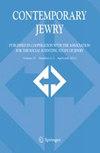Understanding the Current Geographic Disposition of the Jewish Population of England and Wales: Growth and Contraction
Q1 Arts and Humanities
引用次数: 0
Abstract
Abstract The release in March/April 2023 of England and Wales 2021 Census complete data on “usual residents” by the Office for National Statistics provides an opportunity to analyze, understand and comment on the current geographic disposition of Anglo–Jewry. The analysis presented in this paper incorporates data from the 2001 and 2011 censuses, and makes use of a geodemographic assessment of Jewish communities developed from the 2011 census, setting the scene for changes which have taken place, particularly in the last 10 years. Estimates of the scale of births, deaths and net migration in the 2011–2021 period have been developed to explain why the changes in population have taken place. The potential impact of the coronavirus disease 2019 (COVID-19) pandemic on the census results is also considered. A total of 26 sub-communities in the London and Manchester areas, together with 34 free-standing communities, each with more than 200 Jewish residents, have been analyzed in detail. Unexpected changes in Stamford Hill, Gateshead and Bristol are investigated. A total of 42 smaller communities (60–200 members) are also identified. The paper shows that an understanding of the socio-economic characteristic of each of the communities explains their changes in population since 2011, particularly when factors such as “meta-suburbanisation” in the London fringe area, the impact of student numbers in university towns, and special factors affecting Haredi areas are also taken into account. The picture presented is one of a stable (indeed slightly growing) overall population, but with a large variation in fortunes of the many communities which make up Anglo–Jewry.理解当前英格兰和威尔士犹太人口的地理分布:增长与收缩
英国国家统计局(Office for National Statistics)将于2023年3月/ 4月发布2021年英格兰和威尔士人口普查“常住居民”完整数据,为分析、理解和评论盎格鲁犹太人的当前地理分布提供了机会。本文中的分析结合了2001年和2011年人口普查的数据,并利用了2011年人口普查中发展起来的犹太社区的地理人口评估,为已经发生的变化设定了场景,特别是在过去的10年里。编制了2011-2021年期间出生、死亡和净移徙规模的估计数,以解释发生人口变化的原因。此外,还考虑了2019冠状病毒病(COVID-19)大流行对人口普查结果的潜在影响。详细分析了伦敦和曼彻斯特地区的26个亚社区,以及34个独立社区,每个社区都有200多名犹太居民。调查了斯坦福德山、盖茨黑德和布里斯托尔的意外变化。还确定了42个较小的社区(60-200名成员)。本文表明,对每个社区的社会经济特征的理解解释了自2011年以来它们的人口变化,特别是当伦敦边缘地区的“超郊区化”、大学城学生人数的影响以及影响Haredi地区的特殊因素也被考虑在内时。这幅图显示的是总体人口稳定(实际上略有增长),但构成盎格鲁-犹太人的许多社区的命运变化很大。
本文章由计算机程序翻译,如有差异,请以英文原文为准。
求助全文
约1分钟内获得全文
求助全文
来源期刊

Contemporary Jewry
Arts and Humanities-Religious Studies
CiteScore
0.80
自引率
0.00%
发文量
57
期刊介绍:
Contemporary Jewry serves as the single source for the social scientific consideration of world Jewry, its institutions, trends, character, and concerns. In its pages can be found work by leading scholars and important new researchers from North America, Europe, Australasia and Israel. While much relevant scholarship about Jewry is published in general social science journals, as well as more narrowly focused periodicals, no single scholarly journal focuses primarily on the social scientific study of Jewry.Over 500 articles have been published in Contemporary Jewry since its inception. Each issue includes original research articles across a variety of social-science disciplines, including anthropology, demography, economics, education, ethnography, social history, politics, population, social psychology, and sociology. We are open to submissions of shorter research notes, and, on occasion, will publish important work that had originally appeared in Hebrew or other languages. Special issues have focused on such topics as the National Jewish Population Survey, Jewish community surveys, Ultra-Orthodox Jews, Women in the Holocaust, economic frameworks for understanding Jewry, and Jewry in Israel. Individual articles have treated a range of topics, from Jewish identity in Syria and the Ukraine to New Zealand and Israel; from an analysis of rabbis’ salaries to a historical study of Jewish women physicians in Central Europe; from survey research to ethnography to historical analysis. Each year Contemporary Jewry includes the Marshall Sklare Award lecture, delivered at the Association of Jewish Studies conference in co-sponsorship with the Association for the Social Scientific Study of Jewry, the founding association of the journal, by distinguished scholars chosen to receive the award because of their contributions to the field of the social scientific study of Jewry. The distinguished editorial board reflects the multi-disciplinary nature of the journal.Comments or discussion of any of the content in COJE is welcome at http://COJE.forums.com.
 求助内容:
求助内容: 应助结果提醒方式:
应助结果提醒方式:


